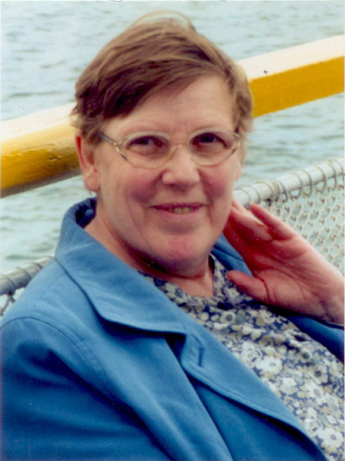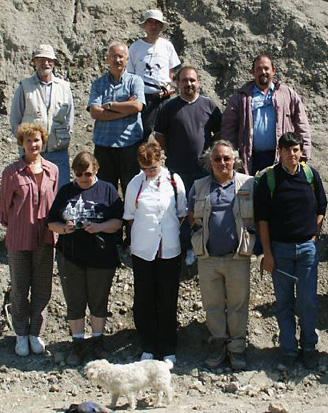Annie Valérie Dhondt
1942 - 2006
There are people whose presence is so familiar that finally, they become an integral part of the Institute's environment. This is the case of Annie Dhondt. I first met Annie in the beginning of the sixties, at a meeting of the "Belgische Jeugdbond voor Natuurstudie" (BJN).  It is interesting to start her biography mentioning this Society, which, at the time, united some hundred 13 to 25-year-old people, who were interested in a large scope of natural history items, such as ornithology, botany, hydrobiology, paleontology... In this small society that delivered four of her scientific colleagues at the Royal Belgian Institute of Natural Sciences, and the same number at the National Botanic Garden, she developed her first interests in natural history. Her younger brother André specialized in ornithology and developed an academic career in this field. Her father was professor of history at the University of Gent, and her mother, who survives her, was also an historian. Maybe this family background was somewhere at the origin of her interests in paleontology, the history of nature?
It is interesting to start her biography mentioning this Society, which, at the time, united some hundred 13 to 25-year-old people, who were interested in a large scope of natural history items, such as ornithology, botany, hydrobiology, paleontology... In this small society that delivered four of her scientific colleagues at the Royal Belgian Institute of Natural Sciences, and the same number at the National Botanic Garden, she developed her first interests in natural history. Her younger brother André specialized in ornithology and developed an academic career in this field. Her father was professor of history at the University of Gent, and her mother, who survives her, was also an historian. Maybe this family background was somewhere at the origin of her interests in paleontology, the history of nature?
Annie started her scientific career at the University of Gent, within the team of Prof. Jean de Heinzelin, preparing a master thesis on the Maastrichtian pectinids from the type area and from Belgium (1965). For her PhD thesis, she widened the scope of the subject, essentially concentrating on the collections of the Institute where at that time Maxime Glibert was curator of the section of Mesozoic and Cenozoic invertebrates. In 1968, she joined the staff of the Institute where she continued her career and, in 1990, became head of the Section of Invertebrate Fossils.
In 1972, Annie obtained a "Postdoctoral Fellowship in Evolutionary and Systematic Biology" at the Smithsonian Institution - Washington D.C., where she worked subsequently for about two years in the Laboratory of Erle Kaufmann, together with Norm Sohl and several other European scientists (Heinz Kollmann, Jiri Krij, Jake Hancock and Jim Kennedy). With this kind of research she was ahead of her time, as at that time most European paleontologists were not used to travel and worked often quite isolated in their regional areas. This stay also gave birth to her everlasting openness and generosity towards foreign colleagues, who always felt her kind hospitality when coming to Belgium. A recent (2006) photograph published in the memorial volume "Jake Hancock" (Proceedings of the Geologist's Association vol. 117-2, p.126) provides a nice illustration of this. Her hospitality was certainly not limited to foreign visitors. Once a year, as long as her health allowed it, she used to invite at her home all the colleagues she regularly met at the Institute for a good meal, proving how excellent her cooking was! Jovial and loquacious, that is how we want Annie to be remembered, with her sharp echoing voice as part of the acoustics of the Institute. In the morning when I entered the corridor of the Paleontology department I often heard the presence of colleague Dhondt, without even having seen her.
Annie V. Dhondt during a trip on a ferry boat at Sevastopol (Crimea, Ukraine) in June 1999 (Picture by Prof. Anatoly Nikishin).
From her PhD and subsequent work at Washington came forth a series of important monographs on Cretaceous pectinids, published between 1971 and 1977 in the Bulletin and the Memoirs of the Institute. Later on, she focused mainly on inoceramids, a fossil mollusk group of primary importance to Cretaceous stratigraphy, and on the paleobiogeography of Cretaceous mollusks. She was fond of traveling and studied fossils in most of the important museums in Europe, North America and the former Soviet Union. Among many other languages, she fluently spoke Russian, and was very interested in the curation of collections and the development of paleontology in the latter country, that for such a long time had been condemned to nearly complete isolation. In 1999, she received the "Peter the Great Award" for contributing to the development of Science and Economy in Russia, as token of gratitude from her Russian colleagues. Until her last years, so far as her health allowed, she took pleasure in her yearly stay of about one month in the Crimea, at the center of geological studies which the Moscow University maintained there, where, together with Russian colleagues, she assisted in the summer school for students.
 She enjoyed participating in international colloquia and field trips dealing with Cretaceous paleontology and stratigraphy, where she often played an important role in the ruling committees. In 1995, she organized in Brussels the "Second Symposium on Cretaceous Stage Boundaries" and also edited the Proceedings of that meeting. This takes us to another topic of her activities, one that required a lot of energy: the edition of the series "Earth Sciences" of the Bulletin of the Institute, that she supervised from 1986 until her early death in 2006. She did it rigorously, without any tolerance for weakness or for linguistic neglect, to great irritation of certain authors, but always with the care of a correct judgment in mind, and a rigorous respect for publication deadlines.
She enjoyed participating in international colloquia and field trips dealing with Cretaceous paleontology and stratigraphy, where she often played an important role in the ruling committees. In 1995, she organized in Brussels the "Second Symposium on Cretaceous Stage Boundaries" and also edited the Proceedings of that meeting. This takes us to another topic of her activities, one that required a lot of energy: the edition of the series "Earth Sciences" of the Bulletin of the Institute, that she supervised from 1986 until her early death in 2006. She did it rigorously, without any tolerance for weakness or for linguistic neglect, to great irritation of certain authors, but always with the care of a correct judgment in mind, and a rigorous respect for publication deadlines.
Annie was gifted with an exceptionally strong memory, allowing her a charming disorder in the organization of her two spacious offices, which reminded of some chaotic sedimentation patterns in the Apennine Mountains. But no problem, we were among geologists, weren't we? This almost unfailing memory is one of the reasons that she never felt the need to keep an updated list of her published papers. The bibliographic list below is as complete as can be hoped for, based on the available documents and compiled by Etienne Steurbaut and Adriano Vandersypen.
Dirk Nolf
Departement Paleontologie

Annie Dhondt, the second from left in the first row, with other participants in the Cantera de Margas, Olazagutia, on 14th September 2002,
during the Meeting on the Coniacian-Santonian Boundary. Bilbao, Spain.

This text is the English version of the Biography of Dr. Annie V. Dhondt, written by Dirk Nolf, Institut Royal des Sciences Naturelles de Belgique.
The complete contribution has been published in the Bulletin de l'Institut des Sciences Naturelles de Belgique 77, 5-14. 2007.
 It is interesting to start her biography mentioning this Society, which, at the time, united some hundred 13 to 25-year-old people, who were interested in a large scope of natural history items, such as ornithology, botany, hydrobiology, paleontology... In this small society that delivered four of her scientific colleagues at the Royal Belgian Institute of Natural Sciences, and the same number at the National Botanic Garden, she developed her first interests in natural history. Her younger brother André specialized in ornithology and developed an academic career in this field. Her father was professor of history at the University of Gent, and her mother, who survives her, was also an historian. Maybe this family background was somewhere at the origin of her interests in paleontology, the history of nature?
It is interesting to start her biography mentioning this Society, which, at the time, united some hundred 13 to 25-year-old people, who were interested in a large scope of natural history items, such as ornithology, botany, hydrobiology, paleontology... In this small society that delivered four of her scientific colleagues at the Royal Belgian Institute of Natural Sciences, and the same number at the National Botanic Garden, she developed her first interests in natural history. Her younger brother André specialized in ornithology and developed an academic career in this field. Her father was professor of history at the University of Gent, and her mother, who survives her, was also an historian. Maybe this family background was somewhere at the origin of her interests in paleontology, the history of nature? She enjoyed participating in international colloquia and field trips dealing with Cretaceous paleontology and stratigraphy, where she often played an important role in the ruling committees. In 1995, she organized in Brussels the "Second Symposium on Cretaceous Stage Boundaries" and also edited the Proceedings of that meeting. This takes us to another topic of her activities, one that required a lot of energy: the edition of the series "Earth Sciences" of the Bulletin of the Institute, that she supervised from 1986 until her early death in 2006. She did it rigorously, without any tolerance for weakness or for linguistic neglect, to great irritation of certain authors, but always with the care of a correct judgment in mind, and a rigorous respect for publication deadlines.
She enjoyed participating in international colloquia and field trips dealing with Cretaceous paleontology and stratigraphy, where she often played an important role in the ruling committees. In 1995, she organized in Brussels the "Second Symposium on Cretaceous Stage Boundaries" and also edited the Proceedings of that meeting. This takes us to another topic of her activities, one that required a lot of energy: the edition of the series "Earth Sciences" of the Bulletin of the Institute, that she supervised from 1986 until her early death in 2006. She did it rigorously, without any tolerance for weakness or for linguistic neglect, to great irritation of certain authors, but always with the care of a correct judgment in mind, and a rigorous respect for publication deadlines.

